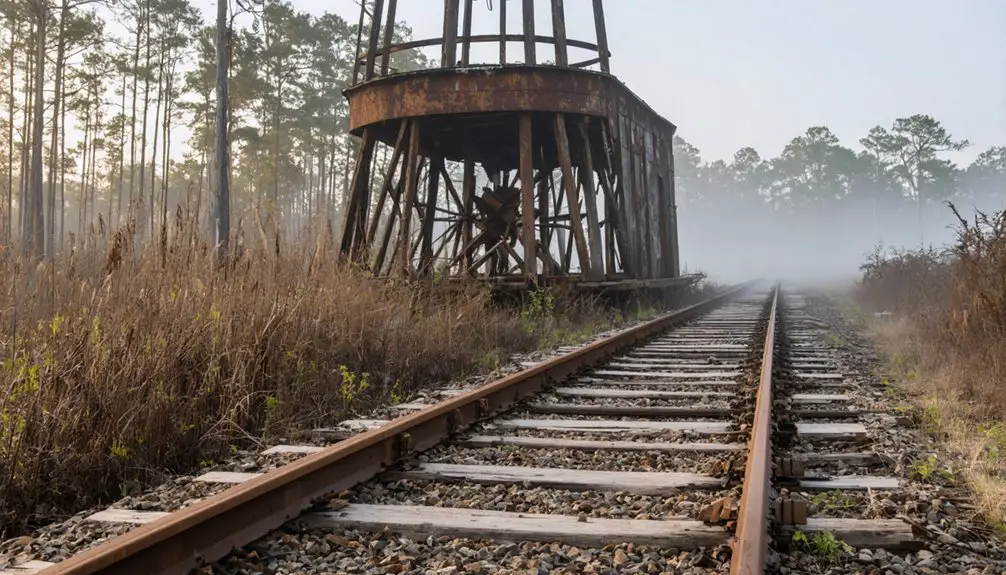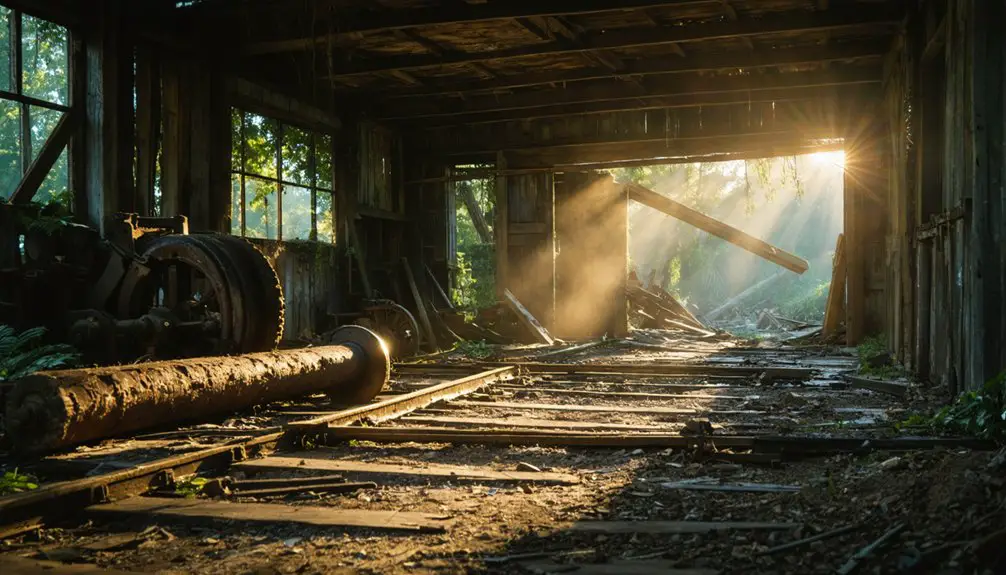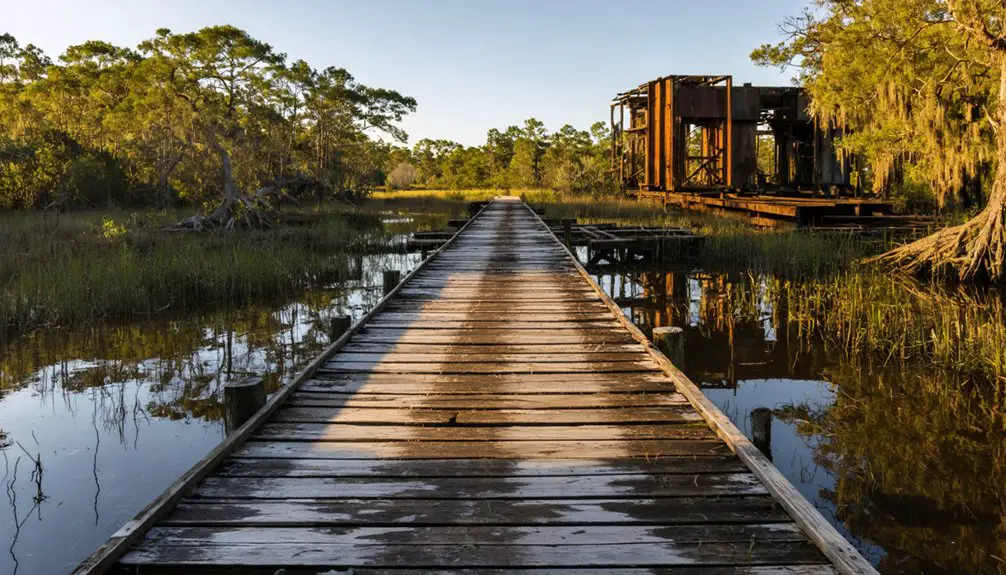You’ll find Sumica’s ghost town remnants in Polk County, Florida, where a French-owned timber operation once thrived from 1917 to 1927. The company town featured 50 worker houses, a commissary that accepted only company scrip, and a railroad network that transported 35,000 board feet of lumber daily. Today, the 4,031-acre Sumica Natural Preserve protects the site’s archaeological treasures and rare wildlife, offering trails that lead you through both industrial ruins and restored wilderness.
Key Takeaways
- Sumica was a French-established lumber town in Polk County, Florida, founded in 1917 and abandoned by 1927 due to forest depletion.
- The company town featured 50 worker houses, a commissary store, church, and school, operating with its own currency system.
- At its peak, Sumica’s sawmill produced 35,000 board feet of lumber daily, transported via the Seaboard Airline Railway.
- The site is now preserved as the 4,031-acre Sumica Natural Preserve, featuring diverse habitats and wildlife.
- Visible remnants include old railroad beds and historical markers, making it an accessible ghost town for visitors to explore.
A French Company’s Vision in Florida
When a French company established Sumica in 1917, they’d ambitious plans for Florida’s pine forests. The Société Universelle des Mines, Industrie, Commerce et Agriculture – “Sumica” for short – saw untapped potential in Polk County’s abundant timber resources.
The ambitious French venture Sumica aimed to transform Florida’s vast pine forests into an industrial powerhouse in 1917.
Their French influence quickly transformed the wilderness into an industrial hub, complete with a sawmill and turpentine plant processing up to 35,000 board feet of lumber daily. Workers could purchase goods using company-issued scrip at the local store. The community grew to support 600 residents at its peak.
This industrial expansion wasn’t just about harvesting trees – it was about building a self-sustaining community. You’ll find they constructed about 50 houses, a commissary, church, and school for their workers.
They even built the Kissimmee River Railway branch line to transport timber and turpentine. The company’s vision extended beyond mere resource extraction, creating a complete company town that would serve their industrial ambitions.
The Rise of a Timber Town
As timber production ramped up in Sumica, the French company’s ambitious plans materialized into a bustling industrial operation. You’d find a robust timber industry churning out 35,000 board feet of lumber daily at the sawmill, while workers extracted valuable turpentine from the abundant pine forests. When Sherman Lumber Co. took over operations, they maintained the town’s industrial momentum.
The community dynamics centered around 50 company houses, where workers and their families made their homes with clay floors and basic wells. You’d see a commissary store where workers used company scrip to buy goods, while a church and school provided essential social foundations. The post office established in March 1917 served as a vital communication hub for the growing community.
The Kissimmee River Railway connected this remote outpost to civilization, with four miles of track stretching into the dense woods for timber access. This transportation lifeline guaranteed Sumica’s place in the regional timber network.
Daily Life in Sumica’s Golden Years
You’d find Sumica’s workers living in basic houses with clay floors and shallow wells, where their wages came in the form of company scrip for use at the commissary store.
The town’s families gathered at the local church and sent their children to the community school, creating a sense of permanence despite the harsh industrial setting. Their community was centered around lumbering and turpentine operations that drove the local economy.
Though living conditions were tough, these shared amenities and gathering places helped forge connections among the timber workers and their families who called Sumica home.
Company Scrip and Commerce
The economic heartbeat of Sumica revolved around its company-controlled currency system and commissary store. You’d have found yourself using aluminum tokens stamped with “SUMICA” as scrip currency, available in 5 and 25 cent denominations, to purchase your daily necessities.
The company store, serving as both marketplace and social hub, stocked essential items like canned foods, basic clothing, and household goods.
This tightly controlled commercial system kept you tethered to Sumica, as your wages came wholly or partially in scrip that you couldn’t spend anywhere else.
While the railroad depot connected the town to outside markets for lumber and turpentine exports, your purchasing power remained strictly limited to the company store, reinforcing the mill owner’s economic grip on daily life.
Workers’ Housing and Amenities
Living conditions in Sumica centered around 50 worker residences built to withstand Florida’s forest environment.
You’d find homes constructed with clapboard siding and durable tin roofs, while clay floors were common inside. Each residence had access to shallow wells for water, and you could spot pine ties on raised beds marking where utility structures once stood.
Worker amenities included essential services like a post office and commissary store, while a rooming house provided accommodations for those without individual homes.
Housing conditions, though basic, featured practical designs suited to the dense pine forest setting. You’d appreciate how the town’s layout clustered homes near the sawmill and community buildings, creating an efficient, self-contained settlement connected by the Seaboard Airline Railway branch.
Church and School Life
During Sumica’s peak years from 1917, church and school life formed the backbone of this remote lumber town’s social fabric.
You’d find the church serving as more than just a place of worship – it was where mill workers and their families gathered for social support and community bonding. Church gatherings provided essential respite from the demanding physical labor of the lumber industry.
The town’s schoolhouse, though modest, gave workers’ children basic education in reading, writing, and arithmetic.
School activities helped create stability in an otherwise transient environment. These institutions worked together to maintain worker morale and encourage families to put down roots.
While little physical evidence remains today, these cornerstones of daily life helped transform what could have been just another work camp into a real community.
Railroad Networks and Transportation Hub

You’ll find that Sumica’s crucial rail network grew substantially when the Seaboard Airline Railway completed its Kissimmee River branch line in 1917, connecting the town to Walinwa and Nalaca.
The railway’s primary purpose was moving the staggering 35,000 board feet of daily lumber production from Sumica’s sawmill to broader markets, while also transporting essential turpentine products from surrounding pine forests.
Today, you can still spot weathered railroad ties at the former town site, marking where trains once transported timber through this bustling transportation hub. By 1922, the sawmill had extended 4 miles of rails into the dense surrounding woodlands for more efficient logging operations.
Railway Growth and Connections
As Sumica’s timber industry flourished in the early 1900s, the Kissimmee River Railway emerged as an essential transportation artery connecting the town to Florida’s broader rail network.
You’ll find this railway expansion was strategically completed in December 1917 as a branch of the Seaboard Airline Railway, revolutionizing freight logistics throughout the region.
The rail system linked Sumica to crucial points including Walinwa on Lake Weohyakapka and Nalaca in Highlands County, creating efficient routes for shipping timber and turpentine products.
The town’s integration with Seaboard’s mainline opened access to Florida’s east coast markets, transforming Sumica into a bustling transportation hub.
Through these connections, you could witness the movement of industrial goods that sustained the town’s economy until its eventual decline in 1927.
Moving Timber to Market
The Kissimmee River Railway‘s infrastructure formed the backbone of Sumica’s timber transport operations, carrying an impressive 35,000 board feet of lumber per day at peak production.
The railway was officially incorporated in 1917 to serve the growing industrial needs of the region.
You’d find about 4 miles of logging trails feeding into the rail system, with specialized loading docks and sidings facilitating efficient timber movement.
As a subsidiary of the Seaboard Air Line Railway, this 7.26-mile branch connected Sumica to crucial turpentine communities like Walinwa and Nalaca.
The rail logistics network revolutionized how Sherman Lumber Company moved its products, replacing slower river transport with direct access to major markets through Plant City.
You can still spot remnants of this industrial heritage in the surviving concrete piers and rail beds, silent witnesses to the bustling timber transport system that once defined Sumica’s economic life.
Rail Infrastructure Remnants
While exploring Sumica’s preserved grounds today, you’ll encounter tangible remnants of its once-bustling rail infrastructure, including foundation ruins from the sawmill complex, scattered railroad ties, and original track beds that have been repurposed into hiking trails.
This railway history offers you a glimpse into Florida’s industrial past, where the Seaboard Airline Railway’s Kissimmee River branch once transported massive quantities of timber and turpentine.
The industrial archaeology visible throughout the preserve follows the paths of former logging railways that connected Sumica to neighboring communities like Walinwa and Nalaca.
Though the tracks were dismantled after the town’s abandonment in the late 1920s, these preserved ruins and converted rail corridors stand as silent witnesses to Sumica’s brief but significant role as a bustling transportation hub.
The Lumber Empire’s Economic Impact

Founded in 1917 by the French Société Universelle des Mines, Industrie Commerce et Agriculture, Sumica’s lumber empire dominated Polk County’s economic landscape through extensive exploitation of longleaf and slash pine forests.
Sumica transformed Polk County’s wilderness into a French-owned industrial powerhouse, building an empire from Florida’s pristine pine forests.
You’ll find evidence of the lumber industry’s massive scale in their daily production of 35,000 board feet and the extensive rail network that connected to the Seaboard Airline Railway.
The economic sustainability of Sumica relied on three key elements:
- A company-controlled local economy with its own currency and commissary
- Integration into regional timber markets through strategic railway connections
- Investment in worker housing and community services to maintain a stable workforce
Behind the Company’s Currency System
Operating as a self-contained economic ecosystem, Sumica’s unique currency system revolved around company-issued scrip that controlled all commerce within the mill town.
You’ll find that workers received their wages in this private currency, which they could only spend at the company store for food, supplies, and daily necessities.
The scrip implications were far-reaching in this closed company economy. By issuing aluminum tokens in denominations like 25 and 5 cents, Sumica maintained tight control over the workforce’s spending habits. This practice followed Florida’s long tradition of private scrip circulation by businesses for store use.
You couldn’t use the currency anywhere else, which often led to financial dependency and limited worker mobility. This system served the company’s interests by ensuring money stayed within their ecosystem until the town’s abandonment in 1927, when timber resources were depleted and the scrip became worthless.
Environmental Changes and Resource Depletion

As Sumica’s sawmill churned out 35,000 board feet of lumber daily, the town’s aggressive harvesting practices rapidly depleted the region’s native long leaf and slash pine forests.
The environmental degradation was severe, with logging trails extending four miles into the surrounding woodlands and turpentine operations systematically killing trees through bark scoring and resin collection.
Poor resource management led to the town’s ultimate abandonment by 1927.
The landscape transformation included:
- Construction of six-foot-high railroad beds for timber transport
- Installation of clay floors, shallow wells, and concrete foundations
- Development of an extensive rail network connecting to other timber communities
Today, you’ll find this 4,000-acre site preserved as an environmental sanctuary, where rare plants and animals thrive among pine flatwoods, marshes, and oak hammocks – a reflection of nature’s resilience. The area now provides a home for twelve rare species that depend on the protected habitats for survival.
The Town’s Final Days
You’ll find that Sumica’s downfall began rapidly in the mid-1920s when local timber resources were nearly exhausted after peak production of 35,000 board feet per day in 1922.
The depletion of pine forests directly led to the closure of both the sawmill and turpentine operations by 1927, eliminating the town’s economic foundation.
As jobs vanished, Sumica’s residents abandoned their homes, the company store, church, and school, leaving behind a ghost town that would soon fade into Florida’s wilderness.
Rapid Resource Depletion
Despite initial prosperity from timber operations, Sumica’s fate was sealed by the aggressive depletion of its natural resources between 1917 and 1927. The French-owned company‘s intensive logging and turpentine production stripped the surrounding pine forests bare, extending at least 4 miles into the woodlands.
Without proper resource management, the town’s economic foundation crumbled as the pine stands vanished.
The devastation of local forests led to three major consequences:
- The sawmill’s daily output of 35,000 board feet came to an abrupt halt
- Railway operations ceased as timber transportation became unnecessary
- The local ecosystem underwent dramatic changes, requiring eventual ecological restoration
You’ll find only concrete foundations and old rail beds today, silent witnesses to a devastating example of unsustainable resource exploitation that turned a bustling mill town into a ghost town.
Population Exodus Patterns
The rapid collapse of Sumica’s timber industry triggered a swift and irreversible population exodus beginning in the mid-1920s. You can trace the population trends through the systematic shutdown of community institutions, culminating with the post office’s closure in June 1927.
The economic shifts left residents with few options as the sawmill, turpentine plant, and company store all ceased operations. Without rail connectivity or alternative employment, families gradually dispersed across Central Florida’s timber communities. Most of Sumica’s 50 households relocated to nearby towns offering better opportunities.
The harsh living conditions, marked by basic housing with pine floors and shallow wells, hastened the exodus. As community fixtures like the church and school closed, the town’s social fabric unraveled, leaving only foundations and water tank remnants as evidence to its brief existence.
Modern-Day Ghost Town Remnants
While most Florida ghost towns have vanished without a trace, Sumica’s remnants still offer glimpses into its lumber-producing past.
Today, you’ll find tangible evidence of this timber legacy scattered throughout a 4,031-acre preserve. The ghost town archaeology reveals foundation ruins of the sawmill, traces of the company store, and an elevated railroad bed that stands six feet above the landscape. Similar to Fort Dade where only one ranger lives permanently, Sumica stands as a testament to Florida’s abandoned settlements.
Scattered across 4,031 acres, crumbling foundations and raised railway beds echo Sumica’s industrial past in this preserve-turned-archaeological treasure.
- The former Seaboard Air Line Railway bed now serves as a hiking and biking trail
- Historical markers and interpretive placards help visitors understand Sumica’s significance
- Scattered remnants of 50 original home sites blend with the recovered pine flatwoods and marshes
You can explore these historical traces via hiking trails while witnessing how nature has reclaimed what was once a bustling lumber town.
Exploring Sumica’s Natural Preserve Today
Modern visitors to Sumica Natural Preserve encounter a remarkable 4,031-acre expanse of protected Florida wilderness, where nature has masterfully woven itself through traces of the old lumber town.
You’ll discover 9.1 miles of trails winding through diverse natural habitats, including pine flatwoods, oak hammocks, and marshes. The elevated railroad bed, once used for timber transport, now serves as a shaded pathway offering panoramic views of the surrounding landscape.
Along these trails, you’ll spot wildlife like wild turkeys, sandhill cranes, and caracaras thriving in their preserved environment.
The preserve’s ecological preservation efforts protect at least 12 rare species while providing you with free access to picnic areas, shelters, and primitive camping.
From Lake Walk-in-Water’s shoreline to the historic remnants, Sumica offers an unfiltered glimpse into Florida’s natural heritage.
Frequently Asked Questions
What Were the Average Wages for Sumica’s Sawmill and Turpentine Workers?
You’d find sawmill workers earned roughly $5-10 weekly, while turpentine workers’ wages were lower, both paid in restrictive company scrip amid harsh worker conditions, though exact wage comparisons remain undocumented.
Were There Any Major Accidents or Deaths During Sumica’s Logging Operations?
You won’t find specific accident records from Sumica’s logging operations, though Florida’s logging industry was notoriously dangerous. While safety issues were common throughout the region, Sumica’s documented fatal incidents remain unclear.
What Happened to the Residents After the Town Was Abandoned?
Like scattered pine needles in the wind, you’d find relocation stories of residents moving to nearby timber towns, while others adapted to cattle ranching and agriculture when economic impacts forced permanent regional dispersal.
Did Any Original Buildings From Sumica Survive Until Modern Times?
You won’t find any complete original buildings standing today – historic preservation wasn’t prioritized. You’ll only see architectural remnants like concrete piers, brick foundations, clay floors, and shallow wells.
Were There Any Native American Settlements in the Area Before Sumica?
While you’ll find Native American historical significance throughout central Florida, there’s no definitive evidence of permanent settlements at Sumica, though indigenous peoples likely used the area seasonally for hunting and gathering.
References
- https://en.wikipedia.org/wiki/Sumica
- https://usgenwebsites.org/flgenweb/FLPolk/hist/Sumica.html
- https://www.youtube.com/watch?v=DKesRivP9VU
- https://floridahikes.com/sumica/
- https://www.hmdb.org/m.asp?m=112124
- http://www.worldofcoins.eu/forum/index.php?topic=8997.0
- https://www.youtube.com/watch?v=vOKR7l2wZZ8
- https://www.polk-county.net/park/sumica/
- https://theforgottensouth.com/florida-turpentine-cabin-history/
- https://www.instagram.com/p/DCzMvusxe9-/railroad-tie-from-the-ghost-town-of-sumica-it-existed-during-the-early-1900s-flo/?hl=fa



